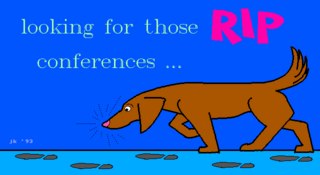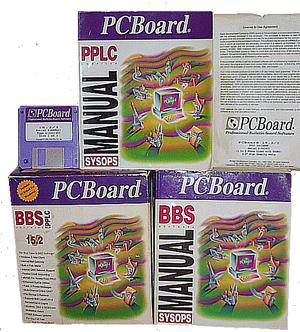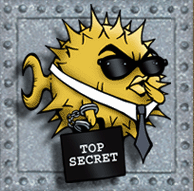| Developer(s) | Rob Swindell, others. |
|---|---|
| Stable release | 3.19b / January 2, 2022 |
| Operating system | Cross-platform |
| Type | Bulletin board system |
| License | GPLv2/LGPLv2 (previous Public domain software) |
| Website | www |
Synchronet is a multiplatform BBS software package, with current ports for Microsoft Windows, Linux, and BSD variants. Past versions also ran on MS-DOS and OS/2, but support for those platforms were dropped in version 3.0 (circa 2000).
Synchronet was originally written by Rob Swindell (a.k.a. Digital Man) due to his desire for certain features which WWIV lacked, such as support for multiple simultaneous nodes, batch uploads and bidirectional file transfer. The bulk of the programming for the first version of Synchronet was done during a two-month period in 1991 when Swindell was house-ridden while he recovered from surgery. The software was named for its ability to run synchronously on a network.
In July 1991, the author began running his own BBS, Vertrauen, on Synchronet. Initially, he had no intention of releasing Synchronet publicly, but as word of his software spread and he received offers to buy copies of Synchronet, he eventually relented, formed a company called Digital Dynamics, and sold copies of Synchronet at a price of $100 without source code, and $200 with source code. In April 1992, Swindell's employer went out of business and he began to rely exclusively on commercial sales of Synchronet for his livelihood, placing advertisements in the BBS-related magazines Boardwatch and BBS Callers Digest . The first copy of Synchronet sold through the magazine ads was in June 1992.
Synchronet was the first BBS package to support QWK message networking natively without requiring any external utilities, in version 1a revision 10, released June 25, 1992. It was also the first BBS package with RIP support, in version 1b revision 1, released January 23, 1993.
Interest in Synchronet began to dwindle in late 1994, finally becoming nonexistent in 1995. Digital Dynamics effectively went bankrupt in the fall of 1995. Despite this, a beta version of version 2.30 of Synchronet for MS-DOS and an alpha version for OS/2 were released in early 1996. In August 1996, Swindell announced the uncertainty of Synchronet's future. In 1997, version 2.30 of Synchronet was released as freeware, and the source code was released into the public domain later that year.
In April 1999, Swindell revived Synchronet development, revamping it considerably and converting much of the code to C++. Another version, 2.30c, was released in December 1999, fixing Y2K bugs and introducing some minor new features from the upcoming 3.x series. Version 3.00b was released June 25, 2000 and was the first official release of the 3.x series, featuring a native 32-bit Windows version and many new Internet-related features, such as a built-in telnet server. For this release, dial-up support was dropped making it a TCP/IP-only system. In October 2000, Synchronet was released under the terms of the GNU General Public License (GPL).
In late 2001, Stephen Hurd (Deuce) joined the project initially as *nix developer. He ported the BBS to FreeBSD and did much of the Linux development work. His first "big" contribution was an implementation of Borlands conio library to allow the configuration utilities which were originally written for DOS to run on the Unix-like platforms.
Around the same time, Swindell started embedding the SpiderMonkey JavaScript engine into Synchronet with an eye towards replacing the aging BAJA language which was used for most BBS customizations. While the BBS still requires BAJA scripts, much can be done with JavaScript. A socket object was added to the JavaScript engine and a "Services" server created which allowed simple TCP/IP services to be written easily. TCP/IP services written in JavaScript bundled with Synchronet include finger, gopher, IRC, and NNTP.
More internet services have been added in the native (C) code: FTP, SMTP and POP3 by Rob Swindell and rlogin, SSH and HTTP by Stephen Hurd.
In an interesting full circle, direct dial-up support for Synchronet is available again as Rob Swindell wrote a modem to telnet gateway program (SEXPOTS) for this purpose. Using this program, SysOps can once again offer their BBSes via direct modem-to-modem connections.
SEXYZ (Synchronet External X-Modem, Y-Modem, Z-Modem) is an external file transfer program which supports X/Y/ZModem transfers. It was written to break the reliance on old DOS external protocols such as [F]DSZ and CEXYZ. It supports TCP socket and stdio transfers. It is functional and very little additional development on this is planned.
SEXPOTS (Synchronet EXternal Plain Old Telephone System) is a modem to telnet gateway. It accepts incoming modem calls and forwards them to the BBS via the Telnet or RLogin protocols.
SyncTERM is terminal emulator which makes use of xpdev, ciolib, UIFC, and parts of SEXYZ and SEXPOTS. In addition to the platforms supported by Synchronet, it also runs on Solaris and Mac OS X.
Supported connectivity options are Telnet, rlogin, SSH, "Raw" sockets, standard modem connections and direct serial connections (using parts of SEXPOTS), and a pty interface on *nix. File transfer options include the ZMODEM, XMODEM and YMODEM transfer protocols (using parts of SEXYZ.)
SyncDraw is an ANSI art editor which was initially a cleanup of an old version of MysticDraw. It uses xpdev and ciolib but is not yet complete. It supports the use of TheDraw fonts, and can save to the Synchronet Control-A code format, but is generally considered too incomplete for serious usage.
The Synchronet project has shown a willingness to "adopt" third-party BBS related software into its CVS tree. Generally, the software is updated to use xpdev and run on the platforms that Synchronet does and then is left in the CVS tree without active development.
Domain Entertainment was once one of the major companies which wrote addons specifically for Synchronet. Some of their software has since been released as open source and has been imported into the Synchronet CVS tree under the xtrn directory.
Domain Poker is a single/multi-player, real-time, 5 card draw poker game. The game can have up to 6 players per table, and up to 25 tables. Each table has a configurable bet limit, ante, and table limit. Tables can be password protected for private games, and the "house" can take a configurable percentage of the pot from games.
Single player games are played against the computer. The computer can be turned off completely, or allowed to play only on certain tables (at your option). You also have the option to not allow the computer to be on password protected tables (to keep users from hogging the tables for themselves).
The Beast's Domain is a multiplayer, interactive, real-time, Rogue-like ANSI adventure game. The Beast's Domain can handle up to 250 simultaneous players.
OpenDoors was one of the most popular C "door kits". Support for the DOOR32 drop file format as well as generic sockets was added by Rob Swindell and *nix compatibility was added by Stephen Hurd.
Other door sources that have been adopted include by developers:

A bulletin board system (BBS), also called a computer bulletin board service (CBBS), was a computer server running software that allowed users to connect to the system using a terminal program. Once logged in, the user can perform functions such as uploading and downloading software and data, reading news and bulletins, and exchanging messages with other users through public message boards and sometimes via direct chatting. In the early 1980s, message networks such as FidoNet were developed to provide services such as NetMail, which is similar to internet-based email.
Telnet is a client/server application protocol that provides access to virtual terminals of remote systems on local area networks or the Internet. Telnet consists of two components: (1) the protocol itself which specifies how two parties are to communicate and (2) the software application that provides the service. User data is interspersed in-band with Telnet control information in an 8-bit byte oriented data connection over the Transmission Control Protocol (TCP). Telnet was developed in 1969 beginning with RFC 15, extended in RFC 855, and standardized as Internet Engineering Task Force (IETF) Internet Standard STD 8, one of the first Internet standards. Telnet transmits all information including usernames and passwords in plaintext so it is not recommended for security-sensitive applications such as remote management of routers. Telnet's use for this purpose has waned significantly in favor of SSH. Some extensions to Telnet which would provide encryption have been proposed.
In computing, the Windows Sockets API (WSA), later shortened to Winsock, is an application programming interface (API) that defines how Windows network application software should access network services, especially TCP/IP. It defines a standard interface between a Windows TCP/IP client application and the underlying TCP/IP protocol stack. The nomenclature is based on the Berkeley sockets API used in BSD for communications between programs.

The Computer Systems Research Group (CSRG) was a research group at the University of California, Berkeley that was dedicated to enhancing AT&T Unix operating system and funded by Defense Advanced Research Projects Agency.

The Remote Imaging Protocol and its associated Remote Imaging Protocol Script language, RIPscrip, is a graphics language that provides a system for sending vector graphics over low-bandwidth links, notably modems. It was originally created by Jeff Reeder, Jim Bergman, and Mark Hayton of TeleGrafix Communications in Huntington Beach, California to enhance bulletin board systems and other applications.
ZMODEM is an inline file transfer protocol developed by Chuck Forsberg in 1986, in a project funded by Telenet in order to improve file transfers on their X.25 network. In addition to dramatically improved performance compared to older protocols, ZMODEM offered restartable transfers, auto-start by the sender, an expanded 32-bit CRC, and control character quoting supporting 8-bit clean transfers, allowing it to be used on networks that would not pass control characters.

PCBoard (PCB) was a bulletin board system (BBS) application first introduced for DOS in 1983 by Clark Development Company. Clark Development was founded by Fred Clark. PCBoard was one of the first commercial BBS packages for DOS systems, and was considered one of the "high end" packages during the rapid expansion of BBS systems in the early 1990s. Like many BBS companies, the rise of the Internet starting around 1994 led to serious downturns in fortunes, and Clark Development went bankrupt in 1997. Most PCB sales were of two-line licenses; additional line licenses were also available.

The Major BBS was bulletin board software developed between 1986 and 1999 by Galacticomm. In 1995 it was renamed Worldgroup Server and bundled with a user client interface program named Worldgroup Manager for Microsoft Windows. Originally DOS-based, two of the versions were also available as a Unix-based edition, and the last versions were also available for Windows NT-based servers.
Mystic BBS is a bulletin board system software program that began in 1995 and was first released to the public in December 1997 for MS-DOS. It has been ported to Microsoft Windows, OS/2, OS X, and Linux. Mystic was designed to be a spiritual successor to the Renegade (BBS) and Telegard bulletin board systems.

A terminal server connects devices with a serial port to a local area network (LAN). Products marketed as terminal servers can be very simple devices that do not offer any security functionality, such as data encryption and user authentication. The primary application scenario is to enable serial devices to access network server applications, or vice versa, where security of the data on the LAN is not generally an issue. There are also many terminal servers on the market that have highly advanced security functionality to ensure that only qualified personnel can access various servers and that any data that is transmitted across the LAN, or over the Internet, is encrypted. Usually, companies that need a terminal server with these advanced functions want to remotely control, monitor, diagnose and troubleshoot equipment over a telecommunications network.
The OpenBSD operating system focuses on security and the development of security features. According to author Michael W. Lucas, OpenBSD "is widely regarded as the most secure operating system available anywhere, under any licensing terms."
The Atari Message Information System (AMIS) was one of the first BBS software packages available for the Atari 8-bit family of computers. It was known to crash pretty often and could not be left unattended for more than a few days. The autorun.sys file which contained the modem handler was at cause. Versions of the AMIS BBS were modified with the modem handler supplied with the Atari XM301 modem and was deemed much more stable.
NetFoss is a popular Network FOSSIL driver for Windows. A FOSSIL is a serial communications layer to allow DOS based software to talk to modems without dealing with hardware I/O and interrupts.
GT Power is a bulletin board system (BBS) and dial-up telecommunications/terminal application for MS-DOS. It was first introduced in the 1980s by P & M Software, founded by Paul Meiners. GT Power can be used both to host a BBS as well as to connect to other BBS systems via its full-featured dial-up "terminal mode". GT Power was a shareware package that required a registration fee in order to access its proprietary network mail transport/handling software and, by default, the GT Power Network. The software is distributed in two "flavors": a terminal-only version, nicknamed GTO, and the full-featured host and terminal version.

The Berkeley Software Distribution or Berkeley Standard Distribution (BSD) is a discontinued operating system based on Research Unix, developed and distributed by the Computer Systems Research Group (CSRG) at the University of California, Berkeley. The term "BSD" commonly refers to its open-source descendants, including FreeBSD, OpenBSD, NetBSD, and DragonFly BSD.
ZOC is a popular computer-based terminal emulator and Telnet software client for the Microsoft Windows and Apple Macintosh macOS operating systems that supports telnet, modem, SSH 1 and 2, ISDN, serial, TAPI, Rlogin and other means of communication. Its terminal emulator supports Xterm emulation with full colors, meta-keys and local printing, VT102, VT220 and several types of ANSI as well as Wyse, TVI, TN3270, and Sun's CDE. It supports full keyboard remapping, scripting in REXX and other languages, and support for named pipes.

SecureCRT is a commercial SSH and Telnet client and terminal emulator by VanDyke Software. Originally a Windows product, VanDyke later added a Mac OS X version in 2010 with release v6.6 and a Linux version in 2011 with release v6.7.

Uzbl is a discontinued free and open-source minimalist web browser designed for simplicity and adherence to the Unix philosophy. Development began in early 2009 and is still considered in alpha software by the developers. The core component of Uzbl is written in C, but other languages are also used, most notably Python. All parts of the Uzbl project are released as free software under GNU GPL-3.0-only.

OpenSSH is a suite of secure networking utilities based on the Secure Shell (SSH) protocol, which provides a secure channel over an unsecured network in a client–server architecture.
NicheStack is a closed source IPv4 network layer and application implementation for operating systems, written in ANSI "C" and is one of three available from InterNiche Technologies, Inc., designed for use in embedded systems. Its transport layer implementation has historical roots in BSD and the IP layer was derived from a Carnegie Mellon University (CMU) implementation.